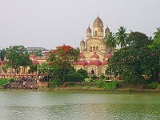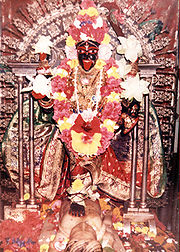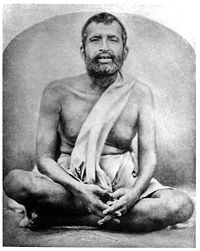
Dakshineswar Kali Temple
Encyclopedia
The Dakshineswar Kali Temple (Bengali
: দক্ষিনেশ্বর কালী মন্দির Dokkhineshshôr Kali Mondir, Sanskrit: दक्षिनेश्वर काली मन्दिर) is a Hindu
temple located in Dakshineswar
near Kolkata
. Situated on the eastern bank of the Hooghly River, the presiding deity of the temple is Bhavatarini, an aspect of Kali
, meaning, 'She who liberates Her devotees from the ocean of existence i.e Saṃsāra
'. The temple was built by Rani Rashmoni
, a philanthropist and a devotee of Kali in 1855. The temple is famous for its association with Ramakrishna
a mystic of 19th Century Bengal.
The temple compound, apart from the nine-spired main temple, contains a large courtyard surrounding the temple, with rooms along the boundary walls. There are twelve shrines dedicated to Shiva
—Kali's companion—along the riverfront, a temple to Radha
-Krishna
, a bathing ghat on the river, a shrine dedicated to Rani Rashmoni. The chamber in the northwestern corner just beyond the last of the Shiva temples, is where Ramakrishna
spent a considerable part of his life.

 The Dakshineswar Kali Temple was founded around the middle of the 19th Century by Rani Rashmoni
The Dakshineswar Kali Temple was founded around the middle of the 19th Century by Rani Rashmoni
. Rani Rashmoni
belonged to Kaivarta caste and was well known for her philanthropic activities. In the year 1847, Rashmoni, prepared to go upon a long pilgrimage
to the sacred Hindu city of Kashi
to express her devotions to the Divine Mother
. Rani was to travel in twenty four boats, carrying relatives, servants and supplies. According to traditional accounts, the night before the pilgrimage began, Rashmoni had a vision of the Divine Mother, in the form of the goddess Kali
in a dream and reportedly said,
Profoundly affected by the dream, Rani immediately looked for and purchased land, and promptly began construction of the temple. The large temple complex was built between 1847 and 1855. The 20 acres (80,937.2 m²) plot was bought from an Englishman, John Hastie and was then popularly known as Saheban Bagicha, partly old Muslim burial ground shaped like a tortoise, considered befitting for the worship of Shakti according to Tantra traditions, it took eight years and nine hundred thousand rupees to complete the construction, and finally the idol of Goddess Kali was installed 31st May 1855, amid festivities at the temple formally known as Sri Sri Jagadishwari Mahakali, with Ramkumar Chhattopadhyay as the head priest; soon his younger brother Gadai or Gadadhar (later known as Ramakrishna
) moved in and so did nephew Hriday to assist him.
The next year, Ramkumar Chhattopadhyay died, the position was given to Ramakrishna, along with his wife Sarada Devi, who stayed in the south side of the Nahabat (music room), in a small room on the ground floor, which now a shrine dedicated to her.
From then until his death 30 years later in 1886, Ramakrishna was responsible for bringing much in the way of both fame and pilgrims to the temple.
 Built in the traditional 'Nava-ratna' or nine spires style of Bengal architecture, the three-storeyed south-facing temple has nine spires distributed in upper two storeys, and stands on a high platform with a flight of stairs, over all it measures 46 feet (14 m) square and rises over 100 feet (30.5 m) high.
Built in the traditional 'Nava-ratna' or nine spires style of Bengal architecture, the three-storeyed south-facing temple has nine spires distributed in upper two storeys, and stands on a high platform with a flight of stairs, over all it measures 46 feet (14 m) square and rises over 100 feet (30.5 m) high.
The garbha griha (sanctum sanctorum
) houses an idol of goddess Kali
idol, known as Bhavataraini, standing on the chest of a lying Shiva
, and the two idols are placed on a thousand-petaled lotus made of silver.
Close to the main temple are the row of twelve identical Shiva
temples built facing the east in the typical ‘Aat Chala’ Bengal architecture, they are built on either side of the ghat on the Hoogly river. To the North east of the Temple Complex is the Vishnu Temple or the Radha Kanta’s Temple. A flight of steps lead to the columned verandah and into the temple where a silver throne rests with a 21 and half inches idol of Lord Krishna and 16 inches (406.4 mm) idol of Radha.
Bengali language
Bengali or Bangla is an eastern Indo-Aryan language. It is native to the region of eastern South Asia known as Bengal, which comprises present day Bangladesh, the Indian state of West Bengal, and parts of the Indian states of Tripura and Assam. It is written with the Bengali script...
: দক্ষিনেশ্বর কালী মন্দির Dokkhineshshôr Kali Mondir, Sanskrit: दक्षिनेश्वर काली मन्दिर) is a Hindu
Hinduism
Hinduism is the predominant and indigenous religious tradition of the Indian Subcontinent. Hinduism is known to its followers as , amongst many other expressions...
temple located in Dakshineswar
Dakshineswar
Dakshineswar is a town in Barrackpore subdivision of North 24 Parganas district in West Bengal.-History:In 1847, Rani Rashmoni of Bengal began the construction of the famous Dakshineswar Kali Temple. Rani, who was a rich and pious widow of colonial Bengal had a divine revelation ordering her to...
near Kolkata
Kolkata
Kolkata , formerly known as Calcutta, is the capital of the Indian state of West Bengal. Located on the east bank of the Hooghly River, it was the commercial capital of East India...
. Situated on the eastern bank of the Hooghly River, the presiding deity of the temple is Bhavatarini, an aspect of Kali
Kali
' , also known as ' , is the Hindu goddess associated with power, shakti. The name Kali comes from kāla, which means black, time, death, lord of death, Shiva. Kali means "the black one". Since Shiva is called Kāla - the eternal time, Kālī, his consort, also means "Time" or "Death" . Hence, Kāli is...
, meaning, 'She who liberates Her devotees from the ocean of existence i.e Saṃsāra
Samsara
thumb|right|200px|Traditional Tibetan painting or [[Thanka]] showing the [[wheel of life]] and realms of saṃsāraSaṅsāra or Saṃsāra , , literally meaning "continuous flow", is the cycle of birth, life, death, rebirth or reincarnation within Hinduism, Buddhism, Bön, Jainism, Sikhism, and other...
'. The temple was built by Rani Rashmoni
Rani Rashmoni
Rani Rashmoni was the founder of the Dakshineswar Kali Temple, Kolkata, and remained closely associated with Sri Ramakrishna Paramhansa after she appointed him as the priest of the temple...
, a philanthropist and a devotee of Kali in 1855. The temple is famous for its association with Ramakrishna
Ramakrishna
Ramakrishna , born Gadadhar Chattopadhyay , was a famous mystic of 19th-century India. His religious school of thought led to the formation of the Ramakrishna Mission by his chief disciple Swami Vivekananda – both were influential figures in the Bengali Renaissance as well as the Hindu...
a mystic of 19th Century Bengal.
The temple compound, apart from the nine-spired main temple, contains a large courtyard surrounding the temple, with rooms along the boundary walls. There are twelve shrines dedicated to Shiva
Shiva
Shiva is a major Hindu deity, and is the destroyer god or transformer among the Trimurti, the Hindu Trinity of the primary aspects of the divine. God Shiva is a yogi who has notice of everything that happens in the world and is the main aspect of life. Yet one with great power lives a life of a...
—Kali's companion—along the riverfront, a temple to Radha
Radha
Radha , also called Radhika, Radharani and Radhikarani, is the childhood friend and lover of Krishna in the Bhagavata Purana, and the Gita Govinda of the Vaisnava traditions of Hinduism...
-Krishna
Krishna
Krishna is a central figure of Hinduism and is traditionally attributed the authorship of the Bhagavad Gita. He is the supreme Being and considered in some monotheistic traditions as an Avatar of Vishnu...
, a bathing ghat on the river, a shrine dedicated to Rani Rashmoni. The chamber in the northwestern corner just beyond the last of the Shiva temples, is where Ramakrishna
Ramakrishna
Ramakrishna , born Gadadhar Chattopadhyay , was a famous mystic of 19th-century India. His religious school of thought led to the formation of the Ramakrishna Mission by his chief disciple Swami Vivekananda – both were influential figures in the Bengali Renaissance as well as the Hindu...
spent a considerable part of his life.
History

Rani Rashmoni
Rani Rashmoni was the founder of the Dakshineswar Kali Temple, Kolkata, and remained closely associated with Sri Ramakrishna Paramhansa after she appointed him as the priest of the temple...
. Rani Rashmoni
Rani Rashmoni
Rani Rashmoni was the founder of the Dakshineswar Kali Temple, Kolkata, and remained closely associated with Sri Ramakrishna Paramhansa after she appointed him as the priest of the temple...
belonged to Kaivarta caste and was well known for her philanthropic activities. In the year 1847, Rashmoni, prepared to go upon a long pilgrimage
Pilgrimage
A pilgrimage is a journey or search of great moral or spiritual significance. Typically, it is a journey to a shrine or other location of importance to a person's beliefs and faith...
to the sacred Hindu city of Kashi
Varanasi
-Etymology:The name Varanasi has its origin possibly from the names of the two rivers Varuna and Assi, for the old city lies in the north shores of the Ganga bounded by its two tributaries, the Varuna and the Asi, with the Ganges being to its south...
to express her devotions to the Divine Mother
Divine Mother
Divine Mother or Mother Divine may refer to*Adi parashakti, a goddess of Hindu Mythology*Blessed Virgin Mary, of Roman Catholicism religion*Father Divine, an American religious leader active in the 1930s, and either of his wives:** Edna Rose Ritchings...
. Rani was to travel in twenty four boats, carrying relatives, servants and supplies. According to traditional accounts, the night before the pilgrimage began, Rashmoni had a vision of the Divine Mother, in the form of the goddess Kali
Kali
' , also known as ' , is the Hindu goddess associated with power, shakti. The name Kali comes from kāla, which means black, time, death, lord of death, Shiva. Kali means "the black one". Since Shiva is called Kāla - the eternal time, Kālī, his consort, also means "Time" or "Death" . Hence, Kāli is...
in a dream and reportedly said,
Profoundly affected by the dream, Rani immediately looked for and purchased land, and promptly began construction of the temple. The large temple complex was built between 1847 and 1855. The 20 acres (80,937.2 m²) plot was bought from an Englishman, John Hastie and was then popularly known as Saheban Bagicha, partly old Muslim burial ground shaped like a tortoise, considered befitting for the worship of Shakti according to Tantra traditions, it took eight years and nine hundred thousand rupees to complete the construction, and finally the idol of Goddess Kali was installed 31st May 1855, amid festivities at the temple formally known as Sri Sri Jagadishwari Mahakali, with Ramkumar Chhattopadhyay as the head priest; soon his younger brother Gadai or Gadadhar (later known as Ramakrishna
Ramakrishna
Ramakrishna , born Gadadhar Chattopadhyay , was a famous mystic of 19th-century India. His religious school of thought led to the formation of the Ramakrishna Mission by his chief disciple Swami Vivekananda – both were influential figures in the Bengali Renaissance as well as the Hindu...
) moved in and so did nephew Hriday to assist him.
The next year, Ramkumar Chhattopadhyay died, the position was given to Ramakrishna, along with his wife Sarada Devi, who stayed in the south side of the Nahabat (music room), in a small room on the ground floor, which now a shrine dedicated to her.
From then until his death 30 years later in 1886, Ramakrishna was responsible for bringing much in the way of both fame and pilgrims to the temple.
Architecture

The garbha griha (sanctum sanctorum
Sanctum sanctorum
The Latin phrase sanctum sanctorum is a Latin translation of the biblical term: "Holy of Holies" which generally refers in Latin texts to the Holiest place of the Tabernacle of Ancient Israel and later the Temples in Jerusalem, but also has some derivative use in application to imitations of the...
) houses an idol of goddess Kali
Kali
' , also known as ' , is the Hindu goddess associated with power, shakti. The name Kali comes from kāla, which means black, time, death, lord of death, Shiva. Kali means "the black one". Since Shiva is called Kāla - the eternal time, Kālī, his consort, also means "Time" or "Death" . Hence, Kāli is...
idol, known as Bhavataraini, standing on the chest of a lying Shiva
Shiva
Shiva is a major Hindu deity, and is the destroyer god or transformer among the Trimurti, the Hindu Trinity of the primary aspects of the divine. God Shiva is a yogi who has notice of everything that happens in the world and is the main aspect of life. Yet one with great power lives a life of a...
, and the two idols are placed on a thousand-petaled lotus made of silver.
Close to the main temple are the row of twelve identical Shiva
Shiva
Shiva is a major Hindu deity, and is the destroyer god or transformer among the Trimurti, the Hindu Trinity of the primary aspects of the divine. God Shiva is a yogi who has notice of everything that happens in the world and is the main aspect of life. Yet one with great power lives a life of a...
temples built facing the east in the typical ‘Aat Chala’ Bengal architecture, they are built on either side of the ghat on the Hoogly river. To the North east of the Temple Complex is the Vishnu Temple or the Radha Kanta’s Temple. A flight of steps lead to the columned verandah and into the temple where a silver throne rests with a 21 and half inches idol of Lord Krishna and 16 inches (406.4 mm) idol of Radha.
Further reading
- The chapter about Dakshineswar Kali Temple in Ramakrishna Kathamritam Sri-Sri-Ramakrisna-kathamrta.

